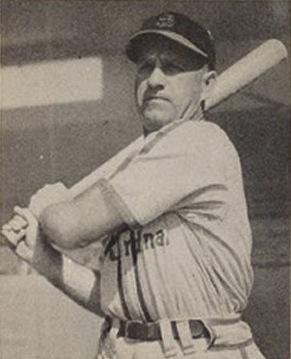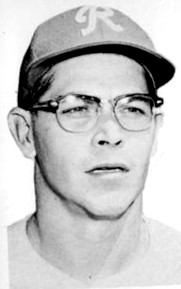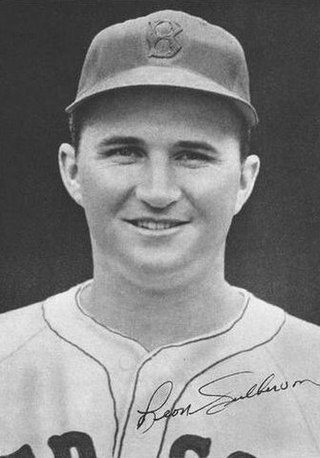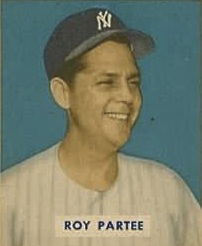
Theodore Samuel Williams was an American professional baseball player and manager. He played his entire 19-year Major League Baseball (MLB) career, primarily as a left fielder, for the Boston Red Sox from 1939 to 1960; his career was interrupted by military service during World War II and the Korean War. Nicknamed "Teddy Ballgame", "the Kid", "the Splendid Splinter", and "the Thumper", Williams is widely regarded as one of the greatest hitters in baseball history and to date is the last player to hit over .400 in a season. His .482 on-base percentage is the highest of all time.

Enos Bradsher Slaughter, nicknamed "Country", was an American Major League Baseball (MLB) right fielder. He played for 19 seasons on four major league teams from 1938 to 1942 and 1946 to 1959. He is noted primarily for his playing for the St. Louis Cardinals and famously scored the winning run in Game 7 of the 1946 World Series for the Cardinals. A ten-time All-Star, he has been elected to both the National Baseball Hall of Fame and St. Louis Cardinals Hall of Fame.

Stanley Frank Musial, nicknamed "Stan the Man", was an American baseball outfielder and first baseman. Widely considered to be one of the greatest and most consistent hitters in baseball history, Musial spent 22 seasons in Major League Baseball (MLB), playing for the St. Louis Cardinals, from 1941 to 1944 and from 1946 to 1963, before becoming a first-ballot inductee into the Baseball Hall of Fame in 1969.

Dominic Paul DiMaggio, nicknamed "the Little Professor", was an American Major League Baseball center fielder. He played his entire 11-year baseball career for the Boston Red Sox (1940–1953). DiMaggio was the youngest of three brothers who each became major league center fielders, the others being Joe and Vince.

John Michael Pesky, nicknamed "the Needle" and "Mr. Red Sox", was an American professional baseball player, manager and coach. He was a shortstop and third baseman during a ten-year major league playing career, appearing in 1,270 games played in 1942 and from 1946 to 1954 for three teams. He missed the 1943–45 seasons while serving in World War II. Pesky was associated with the Boston Red Sox for 61 of his 73 years in baseball—from 1940 through June 3, 1952, 1961 through 1964, and from 1969 until his death. Pesky also managed the Red Sox from 1963 to 1964, and in September 1980.
The 1946 World Series was played in October 1946 between the St. Louis Cardinals and the Boston Red Sox. This was the Red Sox's first appearance in a World Series since their championship of 1918.

Charles Thomas Wagner was an American right-handed pitcher in Major League Baseball who played his entire, 100-game career for the Boston Red Sox. Nicknamed "Broadway," after his playing retirement he went on to a 60-year career as a farm system supervisor, scout, major-league pitching coach and minor-league instructor. His professional relationship with the Red Sox lasted a record 73 years.
The following are the baseball events of the year 1941 throughout the world.
Edwin Hawley Dyer was an American left-handed pitcher, manager and farm system official in Major League Baseball for the St. Louis Cardinals from 1922 to 1944 and 1946–1950. In 1946, Dyer's first season at the helm of the Cardinals, the Redbirds defeated the Brooklyn Dodgers in a thrilling National League season that featured the first postseason playoff in baseball history, then bested the favored Boston Red Sox in a seven-game World Series. He was the second rookie manager to win a World Series and first since Bucky Harris in 1924.

The Mad Dash, or Slaughter's Mad Dash, refers to an event in the eighth inning of the seventh game of the 1946 World Series between the St. Louis Cardinals and the Boston Red Sox.

Jack Wayne Lohrke was a third baseman in Major League Baseball. During his playing career, he stood 6' (183 cm) tall, weighed 180 pounds (81.7 kg) and threw and batted right-handed.

Delbert Leon Culberson was an American professional baseball player. He played as an outfielder in Major League Baseball (MLB) from 1943 to 1948 for the Boston Red Sox and the Washington Senators. Listed at 5 feet 11 inches (1.80 m) and 180 pounds (82 kg), he both batted and threw right-handed.

Robert Harold Klinger was a professional baseball player who was a right-handed pitcher in Major League Baseball over parts of eight seasons from 1938 through 1947. He played for the Pittsburgh Pirates and the Boston Red Sox. In 265 career appearances he compiled a 66–61 record along with 23 saves, with a 3.68 earned run average and 357 strikeouts. His cousin Charlie Hollocher was also a Major League Baseball player.
The 1946 St. Louis Cardinals season was a season in American baseball. It was the team's 65th season in St. Louis, Missouri and their 55th season in the National League. The Cardinals went 96–58 during the championship season and finished tied with the Brooklyn Dodgers for first in the National League. St. Louis then won a best-of-three playoff for the pennant, two games to none. In the World Series, they won in seven games over the Boston Red Sox. They won on Enos Slaughter's "mad dash" that gave them a 4–3 lead in the eighth inning of game 7.
The 1949 Major League Baseball season was contested from April 18 through October 15, 1949. Both the American League (AL) and National League (NL) had eight teams, with each team playing a 154-game schedule. The New York Yankees won the World Series over the Brooklyn Dodgers in five games. Ted Williams of the Boston Red Sox and Jackie Robinson of the Dodgers won the Most Valuable Player Award in the AL and NL, respectively.
The 1946 Major League Baseball season was contested from April 16 to October 15, 1946. The St. Louis Cardinals and Boston Red Sox were the regular season champions of the National League and American League, respectively. The Cardinals defeated the Brooklyn Dodgers in a best-of-three series, for the National League title. It was Major League Baseball's first-ever regular season tie-breaker. The Cardinals then defeated the Red Sox in the World Series, four games to three.

Roy Robert Partee was a Major League Baseball catcher. Listed at 5 ft 10 in (1.78 m), 180 lb (82 kg), Partee was nicknamed the "Little Round Man." He is likely best remembered as the man behind the plate for Enos Slaughter's "mad dash" in game seven of the 1946 World Series and as the New York Mets scout responsible for signing Bud Harrelson, Tug McGraw, Rick Aguilera and Greg Jeffries, among others.

The 1946 Major League Baseball All-Star Game was the 13th playing of the "Midsummer Classic" by Major League Baseball's (MLB) American League (AL) and National League (NL) All-Star teams.
The 1946 National League tie-breaker series was a best-of-three playoff series that extended Major League Baseball's (MLB) 1946 regular season to decide the winner of the National League (NL) pennant. The games were played on October 1 and October 3, 1946, between the St. Louis Cardinals and Brooklyn Dodgers. It was necessary after both teams finished the season with identical win–loss records of 96–58. This was the first ever tie-breaker series in MLB history. The Cardinals won the regular season series, 16–8.

Dugout to Foxhole: Interviews with Baseball Players Whose Careers Were Affected by World War II is a 1994 book written by Rick Van Blair. The book has been cited as a reference source for other baseball books.













